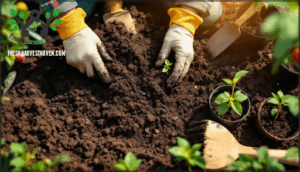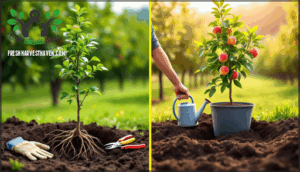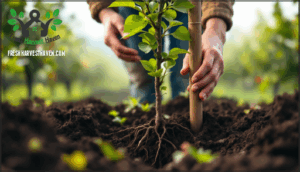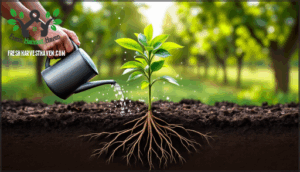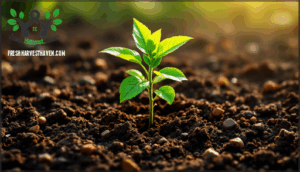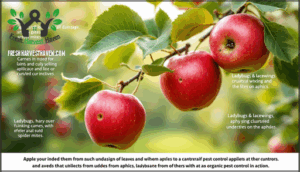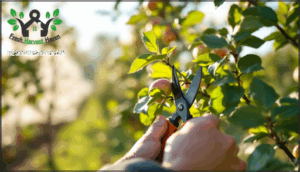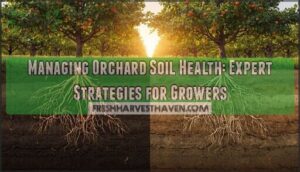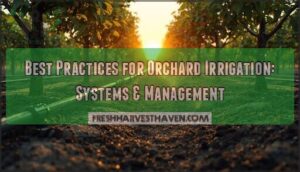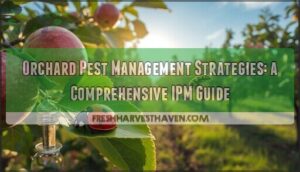This site is supported by our readers. We may earn a commission, at no cost to you, if you purchase through links.
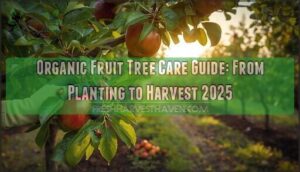
The secret lies in prevention rather than reaction: choosing disease-resistant varieties, feeding the soil ecosystem, and timing your interventions before problems escalate. This approach requires more observation and patience than spraying a bottle of chemicals, but it creates resilient trees that thrive for decades.
From selecting your first sapling to pruning mature branches, organic fruit tree care follows principles that work with nature’s rhythms instead of against them.
Table Of Contents
Key Takeaways
- Disease-resistant cultivars like Liberty apples and Harrow Diamond peaches cut pest pressure by 35-45%, forming the foundation of successful organic orchards without relying on synthetic sprays.
- Soil health drives tree resilience—annual compost applications, proper mulching, and organic amendments create a thriving soil food web that naturally suppresses pathogens and feeds trees for decades.
- Prevention beats reaction in organic pest management through strategic timing of interventions, encouraging beneficial insects, and using targeted organic treatments like neem oil or kaolin clay only when monitoring shows it’s necessary.
- Most fruit trees take 2-5 years to produce their first harvest, but proper establishment through correct planting depth, consistent deep watering, and early spring fertilization sets up stronger root systems that support abundant yields long-term.
Selecting The Right Organic Fruit Trees
Choosing the right fruit tree sets the foundation for years of healthy harvests. You’ll need to think about variety performance, certification standards, disease resistance, and how well each tree matches your local conditions.
Let’s walk through the key factors that help you select trees built for organic success.
Best Fruit Tree Varieties for Organic Gardens
Choosing the right fruit tree varieties sets you up for success in organic gardening. For apples, Liberty stays disease-free in over 90% of trials, while Honeycrisp shows 60% less fire blight. Among stone fruits, Methley plums and Hale-Haven peaches deliver strong yields across zones 5–8. Meyer lemons and Owari satsumas adapt well to warmer climates.
Focus on disease resistance, pollination needs, and climate adaptation when selecting varieties—this reduces pest pressure naturally and boosts your harvest.
Some fruits like strawberries are rich in vitamin C, making them a healthy addition to any garden.
Sourcing Certified Organic Trees
Once you’ve picked your varieties, the next step is finding nurseries that sell truly certified organic stock—not just trees grown without chemicals, but those verified through USDA certification. Look for the USDA organic seal on labels, which confirms compliance with strict organic certification standards.
Regional nurseries often provide better-adapted trees and local guarantees. Compare costs carefully—organic-certified fruit trees usually run 15–30% higher than conventional options, but you’re investing in verified organic fruit tree selection from the start.
Choosing Disease-Resistant Cultivars
After securing certified organic stock, you’ll want to choose fruit trees bred to fight off disease naturally—a cornerstone of successful organic control. Disease-resistant cultivars reduce your reliance on sprays and keep trees healthier through the seasons.
Top disease-resistant cultivars for organic orchards:
- ‘Liberty’ and ‘Enterprise’ apples – Scab-resistant apples immune to apple scab and highly resistant to fire blight
- ‘Williams Pride’ – Total immunity to scab and rust with consistent yields under low-spray conditions
- ‘Harrow Diamond’ peaches – Strong resistance to bacterial spot, cutting fruit tree diseases by roughly 35%
- ‘Black Gold’ cherries – Partial leaf spot resistance, reducing defoliation in humid areas by 40%
- ‘Flordaguard’ rootstock – Nematode resistance extending peach orchard lifespan 5–10 years
Modern breeding programs now use marker-assisted selection to speed the development of cultivars with cross-pollination compatibility and pest management advantages. Understanding disease resilience mechanisms can further inform cultivar selection for prime tree health. Pair at least two complementary varieties—studies show mixing resistant cultivars reduces disease pressure by up to 45%. For best local adaptation, prioritize scab-resistant apples and fire blight resistance if you’re in USDA Zones 5–8.
Climate and Site Considerations
Even disease-resistant cultivars won’t thrive unless climate adaptation and site conditions align. Check your USDA Plant Hardiness Zone first—most fruit trees need 600–1,000 chill hours and proper winter dormancy. Slope intervals of 3–10° improve drainage and reduce frost pockets during bloom.
Soil testing reveals soil pH (target 6.0–7.0) and drainage issues before planting.
Microclimate effects—light, humidity, altitude—directly shape fruit quality, so assess your orchard design early.
Preparing Soil for Organic Fruit Trees
Your soil is the foundation of your organic fruit trees—get it right, and everything else falls into place. Healthy soil leads to strong roots, better disease resistance, and bigger harvests.
Let’s look at three key ways to prepare your soil before planting.
Adding Organic Matter and Compost
Think of compost as nature’s slow-release multivitamin—it feeds your fruit trees everything they need without the chemical rush. Apply a 2-inch layer annually around your tree’s drip line to boost soil health and feed the soil food web.
Compost feeds fruit trees naturally, replacing chemical fertilizers with a 2-inch annual layer that enriches soil and sustains long-term tree health
You can source compost locally, try vermicomposting methods at home, or brew compost tea for extra benefits.
These organic amendments improve structure and fertility without harsh chemicals.
Mulching for Moisture and Weed Control
Lay down a 2–3 inch blanket of organic mulch in a 3-foot circle around your tree, and you’ll cut down on watering while choking out weeds that compete for nutrients. Wood chips, shredded bark, or straw work well for weed suppression and moisture retention. Keep mulch a few inches from the trunk to prevent rot.
This layer regulates soil temperature and gradually adds organic matter as it breaks down, feeding soil health year after year.
Improving Drainage and Soil Structure
If your soil drains slower than a winter cold, your fruit tree’s roots will struggle—or worse, rot before they ever get a chance to thrive. Test your soil composition first—clay-heavy ground needs amending with compost or aged manure to improve soil aeration and structure.
For stubborn drainage problems, consider raised beds or mound planting. These solutions boost soil health and give roots the oxygen they need to flourish.
Planting and Establishing Organic Fruit Trees
Getting your organic fruit tree into the ground properly sets the stage for years of healthy growth and abundant harvests. The choices you make during planting—from the type of tree you select to how you water and feed it in those critical first weeks—directly impact how well your tree establishes.
Let’s walk through the key decisions and techniques that’ll give your organic fruit tree the strongest possible start.
Bare Root Vs. Container-Grown Trees
When you’re choosing between bare root and container-grown fruit trees, you’re really deciding between a sleeper and a sprinter. Bare root trees cost less and ship easier, but they need planting during the dormant season. Container-grown trees transplant year-round with less shock during the acclimation period.
- Bare root trees require careful root pruning and immediate planting but establish strong rootstock connections
- Container-grown fruit trees offer instant visual confirmation of health and easier transportation ease
- Planting season for bare roots runs late winter through early spring when trees are dormant
- Cost comparison shows bare root options generally run 30–50% cheaper than potted equivalents
Proper Planting Techniques
Planting a fruit tree correctly isn’t just about digging a hole—it’s about giving roots room to breathe and setting up years of healthy growth from day one. Dig your hole twice as wide as the root ball but no deeper than the original planting depth.
Prune damaged roots before backfilling soil amended with compost to boost soil health. Stake trees loosely if needed, allowing natural movement to strengthen the trunk.
Watering and Root Establishment
Your newly planted fruit tree won’t thrive on a single deep watering—it needs consistent moisture during its first year to anchor a strong root system that can weather droughts and support heavy fruit loads down the line.
Aim for 1 to 1.5 inches of water weekly, applying it slowly to encourage root depth rather than shallow spreading. Deep watering builds drought resistance by training roots to reach deeper soil layers.
Check soil moisture a few inches down, and keep that 2–3 inch mulch layer in place—it locks in moisture while improving soil health.
Early Fertilization With Organic Amendments
Once roots are finding their footing, a well-timed boost of nitrogen and phosphorus in early spring gives your young tree the fuel it needs to build structure before the growing season kicks into high gear. Compost application works well, or try organic fertilizers rich in those nutrients.
Soil testing helps you avoid overfeeding, while biochar fertilizer improves soil health long-term. Proper nutrient timing and amendment types support root establishment without pushing excessive leafy growth at the expense of strong branches.
Organic Pest and Disease Management
Keeping your fruit trees healthy means staying one step ahead of pests and diseases. Organic methods work best when you know what you’re dealing with and act early.
Here’s how to protect your trees without synthetic chemicals.
Identifying Common Fruit Tree Pests
Have you noticed holes in your apples or sticky residue on leaves? Spotting garden pests early is your first defense in organic pest and disease control. Regular monitoring methods help you catch problems before they spiral out of control. Here are five pests to watch for:
- Codling moth – Look for entry holes near the fruit’s stem and frass (sawdust-like droppings) on apples and pears, especially during summer when seasonal activity peaks.
- Brown marmorated stink bug – Check for dimpled, corky spots on fruit surfaces; this pest damages stone fruits and apples across 41 states.
- Oriental fruit moth – Inspect shoot tips for wilting and fruit for small entry holes; expect three generations between June and September in warmer regions.
- Aphids – Examine new growth for clusters of tiny insects and curled leaves; damage symptoms increase under high-nitrogen conditions.
- European red mite – Search for stippling (tiny yellow dots) on leaves and fine webbing; populations surge in hot, dry weather.
Use pheromone traps for identifying fruit tree diseases and tracking moth flights. This gives you precise timing for biological controls and helps distinguish pest damage from fungal issues like sooty blotch, which resembles insect injury but requires different pest control approaches.
Organic Sprays and Treatments (Neem Oil, Kaolin Clay)
After you’ve identified the pests threatening your trees, it’s time to reach for targeted organic sprays that stop damage without harsh chemicals. Neem oil uses include disrupting insect feeding and reproduction, while Kaolin clay benefits include creating a protective barrier that confuses pests. Both are OMRI-certified options you can apply up to harvest.
Spray application timing matters—Kaolin clay works best at petal fall, and treatment effectiveness comparison shows it reduces pest presence by up to 50% while doubling as an organic fungicide.
Encouraging Beneficial Insects and Pollinators
The real workhorses in your organic orchard aren’t the sprays you apply—they’re the insects and pollinators already living there, ready to hunt pests and pollinate blossoms if you give them the right invitation. Support them by creating pollinator habitats and planting insectary plants like yarrow or buckwheat near your trees. You’ll boost both pest control and pollination:
- Native bees increase crop yields by 18–71% depending on species
- Water sources like shallow dishes encourage beneficial insects to stay
- Reduced spraying protects ladybugs and lacewings that devour aphids
- Flowering herbs between trees attract predators year-round
This sustainable gardening approach strengthens tree health naturally.
Preventing and Managing Fungal Diseases
When fungal diseases strike—apple scab, powdery mildew, brown rot—they can devastate yields, so prevention beats reaction every time. Start with resistant cultivars like Liberty or Gold Rush, which cut infection risk up to 80%.
Good cultural practices matter: remove fallen leaves and fruit mummies to reduce apple scab by 30–40%, prune for airflow, and use drip irrigation instead of overhead watering.
Apply organic fungicides like sulfur or copper early, and encourage beneficial soil microbes with mulch to suppress pathogens naturally.
Pruning and Seasonal Care for Fruit Trees
Pruning shapes your tree’s structure and directly impacts how much fruit you’ll harvest. Timing and technique vary depending on whether you’re growing apples, pears, or stone fruits like peaches and plums.
Here’s what you need to know to keep your trees productive and healthy year-round.
When and How to Prune Different Species
Each species has its own pruning window, and missing it can cost you a year’s worth of fruit. Here’s when to grab your pruning tools:
- Apples and pears: Prune during dormancy, usually late winter before buds swell.
- Stone fruits (peaches, plums): Prune in early spring as buds break to reduce disease risk.
- Citrus: Light summer pruning works best to shape growth.
- Berries: Prune after harvest to encourage next season’s canes.
Understanding species variation in pruning timing protects your harvest and keeps trees productive.
Techniques for Apples, Pears, and Stone Fruits
Apples and pears respond well to thinning cuts that open the canopy, while stone fruits need heading cuts to manage their vigorous growth. For apple pruning and pear training, remove crossed branches and water sprouts to improve air circulation.
Stone fruit trees benefit from fruit thinning early in the season, spacing fruits 4–6 inches apart to prevent limb breakage and boost fruit size. Proper fruit tree pruning techniques reduce fruit tree pest and disease control issues naturally.
Summer Vs. Dormant Pruning
Timing your pruning isn’t just about the calendar—it’s about understanding what your tree needs most at different points in the year. Dormant pruning during winter promotes vigorous spring growth and stronger fruit production.
Summer pruning slows tree vigor, redirects energy to ripening fruit, and improves wound healing when temperatures are warm.
Match your pruning techniques to your goals—dormancy for shaping, summer for controlling size.
Maintaining Tree Health Through The Seasons
Keeping your fruit trees thriving year-round requires adjusting your care routine to match what each season demands. Spring calls for seasonal fertilization and early pest control. Summer focuses on consistent watering and sun protection during heat waves.
Fall is the time to monitor health and prepare for dormancy management. Winter provides a window for pruning and planning organic control methods.
Each phase strengthens fruit tree care and enhances disease control.
Frequently Asked Questions (FAQs)
How often should I fertilize established fruit trees?
Fertilizing established fruit trees works like feeding yourself—timing and balance matter more than frequency. You’ll usually apply organic fertilizer once annually in early spring, before buds swell, to support that season’s growth and fruit production.
Can I grow fruit trees in containers organically?
Yes, you can grow fruit trees organically in containers. Choose dwarf varieties, use quality organic potting soil, and guarantee adequate container size for root growth.
Consistent watering needs and winterizing trees are essential for success.
Whats the best organic solution for fruit drop?
Fruit Drop Causes often include calcium deficiency, stress, or poor pollination.
Address blossom-end rot with organic calcium sprays, maintain consistent watering, and use gentle organic thinning methods early.
Natural hormone sprays like kelp extract improve fruit retention organically.
How do I handle wildlife damage to fruit?
Wildlife deterrents like deer fencing and netting are your first line of defense. Physical barriers work best—install seven-foot fencing for deer and bird netting at ripening.
For gopher control, use wire baskets during planting to protect roots and maintain coexistence strategies through orchard management.
When should I start expecting fruit from new trees?
Most fruit trees take two to five years before their first harvest. Grafting effects and variety influence play big roles—dwarf trees often fruit sooner than standard rootstocks, while pollination needs and environmental factors impact timing too.
Conclusion
The best time to plant a tree was twenty years ago; the second best time is now. Your organic fruit tree care guide journey doesn’t end with the harvest—it deepens with each season as you learn what your soil, your climate, and your particular trees need to thrive.
Disease-resistant varieties, beneficial insects, and rich compost aren’t just alternatives to chemicals; they’re investments in an orchard that gets stronger, not weaker, over time. Your patience today becomes next summer’s abundance.

